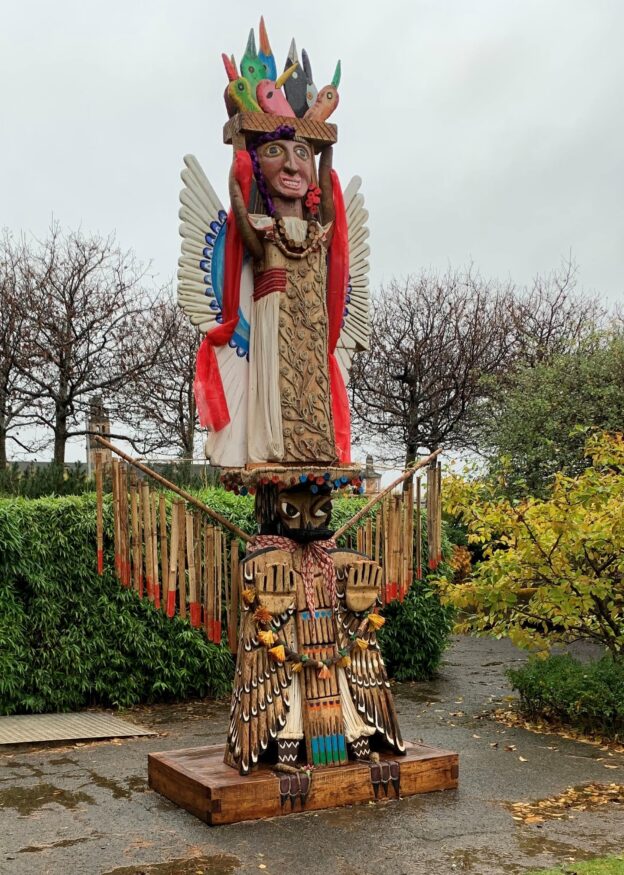By Graham Harvey
In a previous blog I celebrated the journey of Totem Latamat across the UK. The Totem was carved from a single cedar tree, felled with appropriate ceremonies, in the forest of the municipality of Chumatlán near the east coast of Mexico, and travelled to the COP26 Climate Change talks in Glasgow.
The artist, Jun Tiburcio, had been commission to carve Totem Latamat by Border Crossings, a UK company which organises the ORIGINS Festival of First Nations. Covid necessitated changes in the way the festival usually works. Rather than bringing Indigenous performers, speakers, chefs, films and art installations to the UK, Border Crossings presented – and continues to present throughout 2021 and into 2022 – online and onscreen events. But Totem Latamat was commissioned to deliver a message to the COP26.
Having visited seven locations across England, and having been welcomed in a remarkable range of events involving local communities and national media, Totem Latamat arrived at The Hidden Gardens in Glasgow. This was also the base for the Minga Indigena – a Latin American Indigenous collective which has sent delegations and activists to many previous COPs. A ceremony to light a fire that burnt throughout the COP26 weeks included greetings to Totem Latamat. Latamat and the Minga Indigena were among the many works of art (working art) and communities presenting Indigenous experiences, expectations, encouragements and educative messages to the COP26 negotiators and the larger world.
Latamat is in some ways a complex work of art. It includes a carving of an eagle, a woman, a snake, plants, cosmic beings, hummingbirds and more. Each element carries more than one meaning. You can hear Jun Tiburcio’s summary here. However, people who encountered Latamat have been encouraged to reflect on their own responses and interpretations. Border Crossings have posted some of these on social media. Without diminishing the complexity of Totem Latamat or precluding people from responding in their own ways, it might be suggested that the Totem’s message is simple. It can be summed up in three statements:
- Climate change demands urgent action because all species are being affected.
- If humans actively celebrated our place in the larger-than-human community we might take action more urgently.
- Indigenous people recognise human kinship with other species and put respect for “all our relations” at the heart of their efforts to live well.
Totem Latamat’s presentation of kinship, respectful relationships, the necessity of urgent action and the celebration of life has been seen in diverse locations and at COP26. Having done the work required, Totem Latamat has now retired. In a ceremony at the Crichton in Dumfries, the Totem’s journey was celebrated, the message was acknowledged, and the invitation to carry the message further was accepted.
Totem Latamat was dramatically pulled over to lie on – and partly in – the ground. Rather than becoming a monument or museum piece, the Totem will decay gracefully. This was always part of the plan – and part of the gift from Jun Tiburcio and his Totonac community. Totem Latamat’s final resting and rotting also involve the return of carbon to the Earth – a gift from one land to another. A final vital message worthy of the end of journey to challenge carbon consumption and to celebrate the larger-than-human community.
Three themes are of particular interest to me in relation to the Totem’s odyssey: cosmology, ceremony and conscience. Remembering that “Latamat” means “Life” in Jun Tiburcio’s Tutunakú language reinforces the visual recognition of all kinds of life in the carving. The world is here as a community of aquatic, aerial and terrestrial beings together making things happen, shaping reality, propelling evolution in their multi-species community. Many of us who met the Totem demonstrated our kinship with the world by small or large ceremonial acts. Without anyone saying “this is a good thing to do” many people touched the hands of the eagle warrior at the base of the Totem, palm to palm. The final laying down ceremony (much of which can be seen in the film below) extended these more spontaneous greetings into somewhat more dramatic acts. And Totem Latamat’s cosmology of kinship and invitation to do ceremony encourage an ethic of sharing and participation. In describing the Totem, Jun Tiburcio says that when people hear the message brought by hummingbirds (archetypal messengers in his culture), we are invited to carry the message further, becoming hummingbirds ourselves.

